Study on the Mechanism of Jiangzhi Mai'an Granule in Treating Nonalcoholic Fatty Liver Disease Based on Network Pharmacology
, , -, -
(Kunshan TCM Hospital Affiliated to Nanjing University of Chinese Medicine, Kunshan, 215300, China)
ABSTRACT: OBJECTIVE To screen the main active components and action targets of Jiangzhi Mai'an granule by network pharmacology, and to explore its potential mechanism in the treatment of non-alcoholic fatty liver disease (NAFLD). METHODS With the help of the parameter setting of lipid-water partition coefficient (ALogP) and drug similarity (DL) in traditional Chinese medicine system pharmacology database and analysis platform (TCMSP), the chemical components of each drug in Jiangzhi Mai'an granule were collected. The target and disease genes of Jiangzhi Mai'an granule in the treatment of non-alcoholic fatty liver were obtained by integrating the target prediction website server (uniprot) with human gene database (Genecard) and human Mendelian genetic database (OMIM). The protein interaction (PPI) network was constructed by using STRING online tool, and the "traditional Chinese medicine-component-disease-target" network was constructed with the help of Cystoscap 3.6.0. In addition, Cytoscape 3.7.2 software was used for network topology analysis, MCODE plug-in was used to screen key genes, and STRING database and R3.6.3 software were used for gene ontology (GO) classification and enrichment analysis based on Kyoto encyclopedia of genes and genomes (KEGG) pathway. RESULTS A total of 283 potentially active components were obtained, including quercetin, apigenin, kaempferol and other key compounds. Through topological analysis, 13 core targets, 6 gene clusters and 4 core gene CASP9, PTGS2, SLC2A4, OPRD1 were obtained, which are mainly involved in PI3K/Akt, AGE-RAGE, FOXO, IL-17, HIF-1 signal pathway and so on. CONCLUSION The analysis of network pharmacology is helpful to reveal the main material basis of Jiangzhi Mai'an granule in the treatment of NAFLD, predict its potential mechanism of multi-level, multi-target and multi-pathway, and provide a scientific basis for expanding clinical application.
KEYWORDS: Jiangzhi Mai'an granule; non-alcoholic fatty liver disease; cluster analysis; metabolic pathway; gene target; network pharmacology
Worldwide, non-alcoholic fatty liver disease (NAFLD) is a common chronic liver disease, and the resulting NAFLD has become a major public health problem. With the increase in the number of patients with diabetes and obesity, NAFLD has become more and more common, and its prevalence rate has increased from 15% in 2005 to 25% in recent 5 years, and the prevalence rate of adults in many countries has even reached 30%. Modern studies have shown that its pathogenesis is usually closely related to obesity and metabolic syndrome, including obesity, type 2 diabetes, dyslipidemia and metabolic syndrome. There is still no effective drug treatment for non-alcoholic fatty liver diseases related to type 2 diabetes[1-3],which brings increasingly severe challenges to clinical treatment and prevention.
Although NAFLD is generally considered to begin in the early stages, 25% of patients progress to more serious diseases, and if poorly controlled, they can easily develop into non-alcoholic steatohepatitis (NASH), advanced fibrosis, liver cirrhosis, and even liver cancer, becoming one of the leading causes of death[4-6].
Traditional Chinese medicine pays attention to syndrome differentiation and treatment as a whole, and achieves the exact curative effect with the help of the advantages of multi-target and multi-way comprehensive action of compound traditional Chinese medicine. We believe that NAFLD is located in blood and liver,causing deficiency in kidney, involving spleen and stomach, but actually it is turbid phlegm, blood stasis and qi stagnation. The transport function of spleen and stomach is the key to affecting glucose and lipid metabolism, and phlegm and blood stasis in blood vessels is the pathological feature of hyperlipidemic fatty liver. For this reason, we selected six kinds of traditional Chinese medicine, such as Astragali Radix, Salviae miltiorrhizae Radix , Cassiae Semen, Crataegi Fructus, Hordei fructus Germinatus and Nelumbinis Folium, to make Jiangzhi Mai'an granule (JZMA), which has been used in the treatment of hyperlipidemia and fatty liver for nearly 20 years[7]. On this basis, the study also preliminarily confirms that JZMA can regulate a variety of risk factors and pathological links of NAFLD, which effectively improve the liver function of NAFLD and correct the disorder of blood lipid metabolism, and its therapeutic mechanism is closely related to the decrease of insulin resistance index and the increase of serum ADP level[8].
However, up to now, there is only a single component content of JZMA[9], and there is a lack of in-depth and clear research on its effective components and mechanism of action in the treatment of NAFLD, which can not reflect the characteristics of multi-components, multi-targets and multi-pathways of compound traditional Chinese medicine[10], which limits its clinical application.
At present, due to the rapid development of bioinformatics, the method of network pharmacology has become a new means to effectively reveal the molecular mechanism of traditional Chinese medicine prescriptions. Based on the TCMSP platform, by integrating multiple database resources, the model has been changed from "single target, single drug" to "network target, multi-component therapy", and the regulatory principle network of "drug-target-disease" has been systematically demonstrated in a high-throughput manner. this method is very useful for analyzing drug combinations, especially traditional Chinese medicine (TCM) preparations[10-13], and has become a powerful means of traditional Chinese medicine research. It is helpful to expand the clinical indications of the drug and promote the progress of new drug development.
This study reveals its scientific connotation by means of active component prediction, target mining and network construction, through the evaluation of the effective components and action targets of JZMA, in order to predict the pharmacodynamic basis and action mechanism of JZMA in the treatment of NAFLD, and to provide scientific basis for rational clinical application[14].
1 Material and Methods
1.1 Network analysis process
The compounds in herbs were obtained by using the Tradition Chinese Medicine Systems Pharmacology Database(TCMSP;http://tcmspw.com/tcmsp.php), and the candidate compounds were screened by drug-like properties(DL) and lipid-water partition coefficient(ALogP), and matched with the publicly available human protein database(http://www.uniprot.org/). The human disease database(https://www.malacards.org/MalaCards) was used to map the disease target genes of non-alcoholic fatty liver. Use relevant open databases for path analysis and network construction[15-16]. The workflow was shown in Fig.1.

Figure.1 Workflow of network pharmacology analysis
1.2 Screening of potential target genes of drugs acting on diseases
The candidate compounds with DL ≥ 0.18 and ALogP < 5 were matched to human-related target proteins[17-18], and then the active ingredient target genes for the treatment of non-alcoholic fatty liver were located by using Gene Cards database (http://www.genecards.org/) and human Mendelian genetic database (OMIM, https://www.omim.org/) search. By using the production software Venny 2.1, the selected drug targets and disease targets were inputted into the mapping tool (http: / / bioinformatics.psb.ugent.be/ webtools/Venn/) to match the targets of JZMA and NAFLD and draw the Wayne diagram. The overlap and intersection part is the target of JZMA acting on NAFLD, which is the main target of late pathway enrichment analysis[19-20].
1.3 Network Construction and Topology Analysis
With the help of STRING database (https://string-db.org/cgi/input.pl), the protein-protein interaction network is constructed, and the species is set to "Homo sapiens", in which the chemical composition or target is represented by network nodes, and the relationship between them is represented by edges[21-22]. At the same time, the complex relationship network of "drug-component-disease-target" is constructed by using the merging function of Cytoscape3.6.0 (http://www.cytoscape.org/). According to the four important parameters of Degree, Betweenness Centrality, AveragesHortestpath Length and Closeness Centrality, the topology analysis of the important nodes in the network is carried out[23]. Using the MCODE module of Cytoscape3.7.2, the constructed PPI network is imported into the ClusterViz plug-in, and the parameter K-Core is set to 2, that is, the identified module contains at least three edges[24-25], so as to realize gene cluster analysis and core target screening.
1.4 Gene ontology(GO) classification and enrichment analysis
The potential action targets of the active components were introduced into the functional annotation tool, and the species was defined as human. Three parts of molecular functional (molecular function, MF), biological process (biological process, BP) and cell composition (cellular component, CC) under Gene Ontology were selected for GO enrichment analysis. Methods are citing the STRING database, setting the correction P value ≤ 0.05, looking for the main functional notes andinvivopathways for significant enrichment of active component targets, using R3.6.3 software, installing and quoting clusterProfiler,enrichplot,ggplot2 package, drawing bar chart and bubble chart to show the results[26].
1.5 Kyoto Encyclopedia of Genes and Genomes(KEGG) pathway analyses
Using the search tool of STRING database (the predicted protein-protein interaction information provided by https://string-db.org/) and the data confirmed by the experiment, the Uniprot ID corresponding to the potential target was introduced[27-28], the correctionPvalue was set ≤ 0.05,
and then the KEGG signal pathway of the previous prediction target was analyzed; using R3.6.3, after installing and referencing the clusterProfiler package, the KEGG column chart and bubble chart were drawn.
2 Results
2.1 Candidate compounds and target analysis
A total of 975 chemical constituents of JZMA were obtained, including 87in Astragali Radix, 202 in Salviae miltiorrhizae Radix, 175 in Cassiae Semen, 278 in Crataegi Fructus, 140 in Hordei fructus Germinatus and 93 in Nelumbinis Folium, and the potential active components were 40,110,47,14,25 and 47 respectively. After corresponding targets one by one, the predicted targets were 218,155,68,173,79,199,295 compound targets were obtained after removing repetition.
2.2 Potential targets of drugs in the treatment of diseases
Through the database, the number of gene targets related to NAFLD were 980,462 respectively. After weight removal, 1 411 targets were obtained. After mapping with the targets related to the active compounds and introducing the Wayne diagram software, 109 potential targets of active components on the disease were obtained[20]. As shown in Fig. 2.
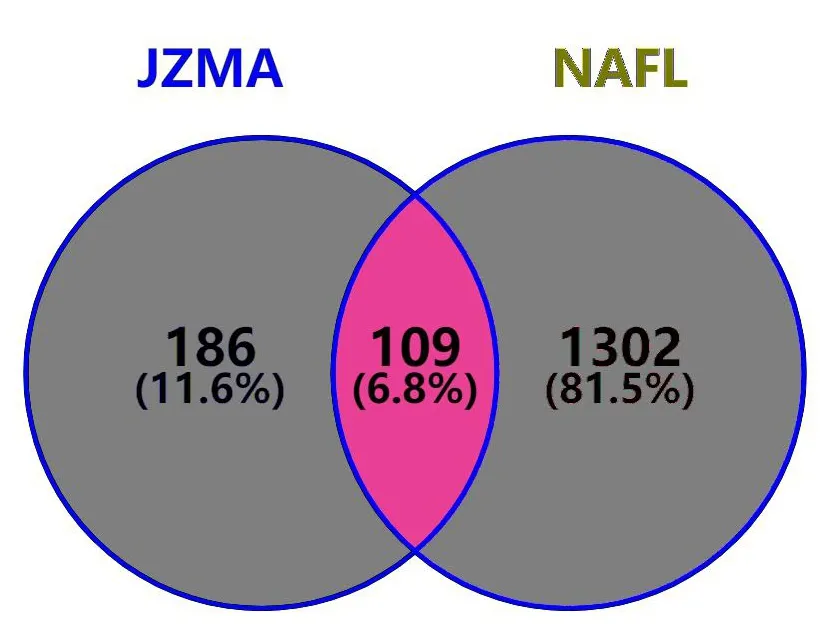
Figure.2 Wayne diagram of compound action target and disease target
2.3 PPI network analysis
The interaction relationship between them was obtained by importing 109 target proteins into STRING database, the PPI network diagram was drawn, and the core index of interaction was obtained[29]. As shown in Fig.3, the network consists of 108 nodes and 495 edges. The thickness of the edges in the graph indicates that the thicker the Combinescore edge is, the larger the Combinescore value is, and the larger the degree value is, the larger the node is, suggesting that its target plays a key role in network regulation and is likely to be the key target of JZMA in the treatment of NAFLD[30]. Finally, 13 core targets larger than the average value were selected according to the descending order of the value, among which the top 5 target proteins were PTGS2, PRSS1, RXRA, ADRB2 and DPP4, indicating that these proteins may play a key role in the effectiveness of treatment[14,31].

Figure. 3 PPI network diagram of JZMA
2.4 Network Construction and key Gene screening
The "traditional Chinese medicine-component-disease-target" network was constructed with 6 traditional Chinese medicines, 283 potential active components and 109 action targets in JZMA. As is shown in Fig.4. The results showed that there were 177 components directly connected with the action target, which were the active components of JZMA in the treatment of NAFLD. Among them, quercetin, apigenin, daidzein, kaempferol, luteolin and other components can connect with more than 30 targets, which can be considered as key compounds. At the same time, different active compounds can act on the same target, and the same active compound can also act on different targets, indicating that JZMA may play a role through the combination of multi-components and multi-targets[ 23,32]. As is shown in Table 1. Among them, the number of ligation between target gene PTGS2 and compound was 21, NCOA1 was 15, OPRM1 and AChE were 13, ADRB2 was 12, PRSS1 was 11, OPRD1 was 10, indicating that these seven target genes play an important role in the treatment of NAFLD by JZMA. The PPI network is analyzed by using topological theory, and the importance of genes is evaluated by calculating the Degree of nodes in the network[33]. The k-kernel analysis is completed by the MOCE plug-in in CytoScape, and after setting the k-core threshold[34], a total of 6 gene clusters and 4 core genes are obtained, which are CASP9, PTGS2, SLC2A4 and OPRD1. As is shown in Fig.5.

Note: yellow is the target of drug action on disease, blue is the active ingredient of traditional Chinese medicine, purple is six kinds of traditional Chinese medicine, and red is disease (NAFLD).

Table 1 Basic information of key compounds of JZMA (target number≥ 30)

(Continued table)


Figure. 5 Cluster analysis of core gene clusters
2.5 GO enrichment analysis
GO entries were obtained by enrichment analysis, including 2 151 BP entries, 66 CC entries and 139 MF entries. Sort by the value of-lgP and select the first 10 entries[34], as is shown in figure 6 a and b. In BP, the target mainly involves response to nutrient levels, response to steroid hormone, response to lipopolysaccharide, etc.; in CC, the target mainly involves membrane raft, membrane microdomain, membrane region, etc; in MF, the target mainly involves DNA-binding transcription activator activity, RNA polymerase Ⅱ-specific, cytokine receptor binding, neuro transmitter receptor activity and so on.
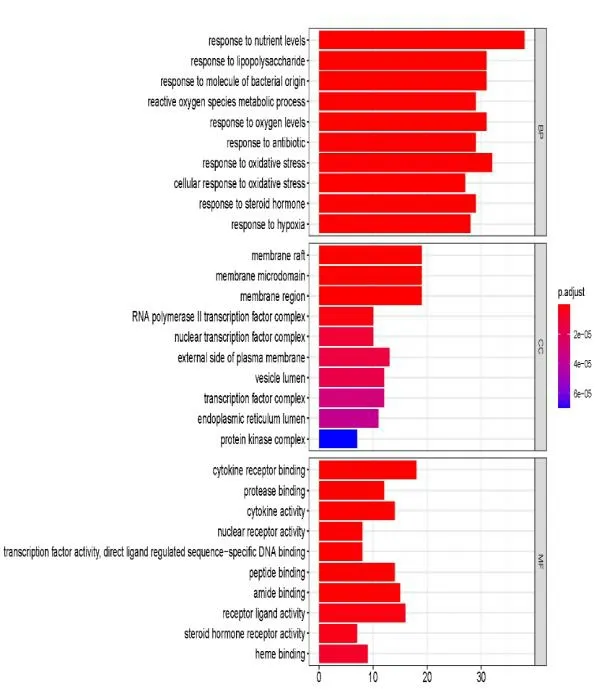
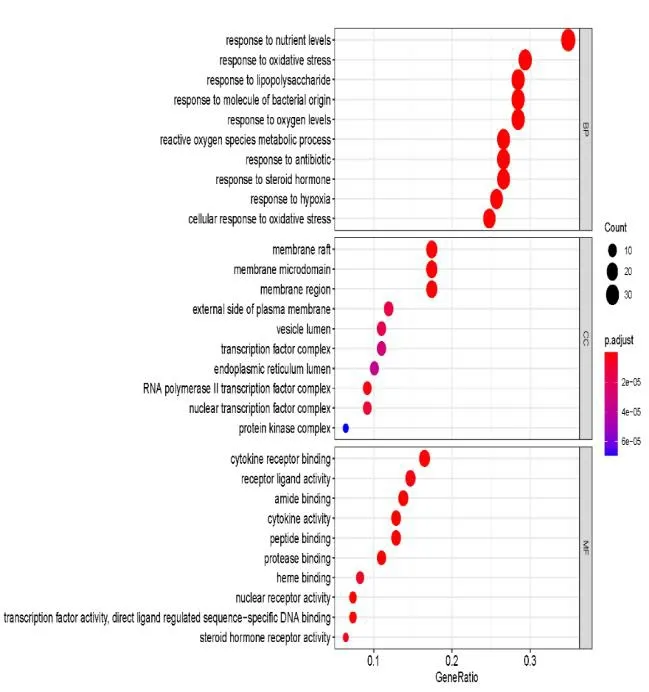
GO analysis bar chart GO analysis bubble chart
2.6 KEGG pathway enrichment analysis
146 signal pathways were obtained by analysis, and were sorted according to the value of-lgP, and the first 10 items were selected to draw the bar chart and bubble chart, as is shown in figure 7a and b. Among them, the redder the color is, the more obvious it is, and the larger the bubble is, the more the number of genes is enriched. It can be seen that the more gene products (targets) are contained in the pathway, the more likely these pathways are the key pathways for JZMA to play a role[35-36]. From the results, the KEGG signal pathways involved in disease targets are mainly involved in PI3K-Akt signaling pathway, AGE-RAGE signaling pathway in diabetic complications, Kaposi sarcoma-associated herpesvirus infection, Hepatitis C and other pathways. The PI3K-Akt pathway involves 25 targets such as RXRA, RELA, EGFR, AKT1, VEGFA, CCND1, CDKN1A, CASP9, IL6, IL4, etc., and the AGE-RAGE pathway involves 24 targets such as RELA, AKT1, VEGFA, CCND1, MMP2, JUN, IL6, CASP3, ICAM-1, STAT3, IL13, SERPINE1, IL1B, CCL2, CXCL8, COL1A1, IL1A, COL3A1, MAPK8, etc.[34], The infection pathway of herpesvirus associated with Kaposi's sarcoma involves 22 targets such as PTGS2, RELA, CASP9, JUN, IL6, CASP3, ICAM-1, GSK3B, STAT3, MYC and so on. Hepatitis C signal pathway involves 21 targets, such as RXRA, RELA, EGFR, AKT1, CCND1, CDKN1A, CASP9, IFNG, GSK3B, CYCS, CFLAR, STAT1, PPARA, CXCL10, CHUK, E2F1, IKBKB, LDLR and so on. The results showed that the active component targets of JZMA were distributed in different pathways and could play a role in coordination through each pathway[37].
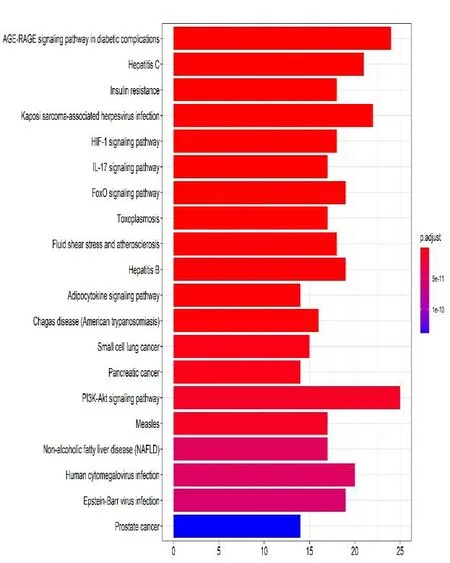
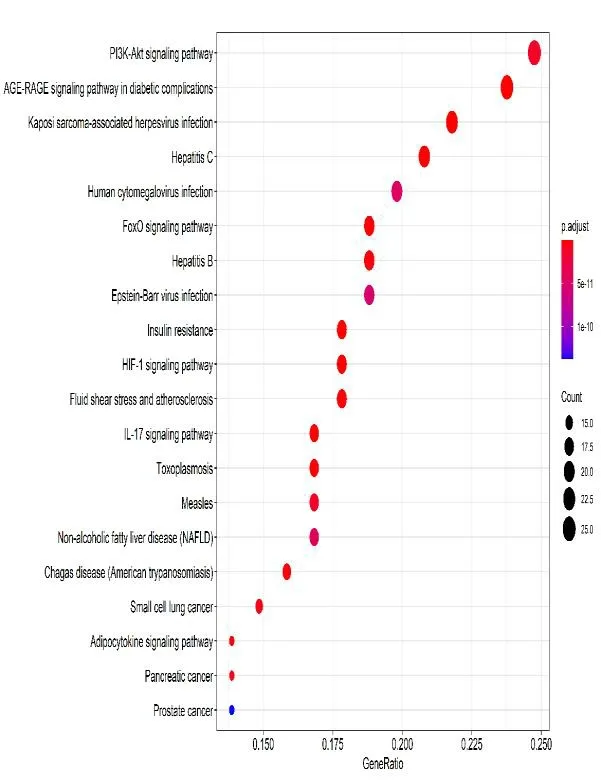
KEGG analysis bar chart KEGG analysis bubble chart
3 Discussion
From the previous clinical treatment, JZMA is effective in the treatment of NAFLD. However, compared with the single component and single target of western medicine, the compound prescription of traditional Chinese medicine has the characteristics of multi-component, multi-target and multi-pathway interaction, so the action mechanism of JZMA has not been systematically explained[38]. With the help of the method of network pharmacology, this study analyzes multi-active components and multi-targets, breaks through the limitations of single molecule and single target, and is very suitable for the overall study of the action mechanism of JZMA[39].
Some scholars believe that excessive fatty acid accumulation will lead to obesity, which in turn leads to NAFLD and NASH,. Its pathogenesis is related to the increase of new fat production of (DNL) and liver glucose production of (HGP)[40]. JZMA is based on the concept of transporting spleen, dispelling blood stasis and removing turbid, in order to reduce fat accumulation. From the number of key compounds and corresponding targets, quercetin, daidzein, apigenin, kaempferol and luteolin and other components have a high frequency of connection with disease targets, which are likely to be the main active components of JZMA in the treatment of NAFLD[14]. Quercetin, the main compound in astragalus, lotus leaf and Hawthorn, could increase the expression of SCD1 and decrease the expression of LXR- α[41]. Kaempferol could effectively inhibit lipid accumulation in macrophages induced by oxidized low density lipoprotein (oxLDL)[42]. Apigenin in Salvia miltiorrhiza could improve liver function and blood lipid metabolism, and increase the levels of IL13 and SOD[43]. Tanshinone Ⅱ A can decrease the transcription of TNF-α, TGFβ1 and IL1, inhibit inflammation and lipid accumulation, and reduce lipid deposition in hepatocytes[44]. Emodin in semen Cassiae can improve the mechanism of lipid deposition in liver of NAFLD model, and inhibit the secretion of serum TNF-α, IL-1 and the expression of TLR4 signal[45]. Accordingly, the progression of NAFLD may involve the occurrence of "parallel multiple strikes" damage, which is marked by oxidative stress-induced mitochondrial dysfunction, endoplasmic reticulum stress, endotoxin-induced TLR4-dependent release of inflammatory cytokines and iron overload, which trigger multi-signal cascades that lead to inflammation, cell death and fibrosis[46]. It can be seen that many components in JZMA, such as quercetin, apigenin, kaempferol and tanshinone ⅡA, may inhibit and slow down fat accumulation and inflammation through multi-stage synergism, thus achieving a definite therapeutic effect on NAFLD. It is also reflected in the complex interaction shown by the "traditional Chinese medicine-component-disease-target" network, which highlights the potential therapeutic value of JZMA for the disease.
In addition, the multi-line interlaced network of PPI suggests the mechanism of JZMA in the treatment of NAFLD, and its effective components may cooperate through target protein networks such as PTGS2, PRSS1, RXRA, ADRB2 and DPP4, and PTGS2 is one of the four core genes in topological analysis. PTGS2, also known as cyclooxygenase-2 (COX-2), participates in the development and regression of acute inflammation, and is itself the therapeutic target of non-steroidal anti-inflammatory drug (NSAIDs)[47]. Serine protease 1 (PRSS1), also known as cationic trypsin 1, belongs to a T cell receptor protein, which is an important regulator of tumor signal transduction and activity. it can quickly activate other protein receptors/ligands on the cell surface to regulate cell proliferation, and participate in the pathological process of cell proliferation, differentiation, migration and invasion through MAPK/ERK signal transduction pathway. It has been found that PRSS1 protein is highly expressed in pancreatic cancer and other tumors, and its mutation can cause endoplasmic reticulum stress and cause disease[48-49]. In addition, the results of topological analysis of core protein network show that this process may also be related to a variety of lipoproteins or vascular endothelial inflammatory factors, such as fatty acid synthase (fatty acid synthase, FASN)[50], hydroxymethyl glutarate monoacyl-CoA reductase (HMGCR)[51], peroxisome proliferator-activated receptor (PPARa)[52], C-reactive protein (CRP)[53], interleukin-10 (IL-10)[54], etc. Its therapeutic effect involves fatty acid synthesis and metabolism, cellular immune response, inflammatory reaction and so on. The formation of NAFLD happens to be related to the disorder of lipid metabolism and the increase of the level of pro-inflammatory factors and the decrease of anti-inflammatory factors[55], which fully proves that the treatment of NAFLD with JZMA is the result of multi-molecule, multi-target and multi-pathway interaction[56], and also points out the direction for the rational prescription of traditional Chinese medicine.
In this study, GO functional enrichment analysis found that these direct target proteins were mainly concentrated in response, receptor regulation, fatty acid metabolism and iron binding[57-59]. In the process of BP, there are the most related items, and the targets are rich in nutrition level response (GO:0031667), oxidative stress reaction (GO:0006979), reaction to lipopolysaccharide (GO:0032496), reaction to bacterial molecules (GO:0002237), response to oxygen content (GO:0070482) and active oxygen metabolism (GO:0072593). While cytokine receptor binding (GO:GO:0005126), receptor ligand activity (GO:0048018), amide binding (GO:0033218), cytokine activity (GO:0005125), peptide binding (GO:GO:0042277), protease binding (GO:0002020) and DNA binding transcriptional activator activity, RNA polymerase II specificity (GO:0001228) is the most abundant MF process. In the aspect of CC, it is enriched into processes such as membrane raft (GO:0045121), lateral plasma membrane (GO:0009897), transcription factor complex (GO:0005667), endoplasmic reticulum lumen (GO:0005788) and so on[60]. At present, there is a general consensus that intestinal microflora, oxidative stress and mitochondrial damage play a key role in the pathogenesis of NASH, while NAFLD is closely related to oxidative stress (OS), in addition, the changes of endoplasmic reticulum stress and NADPH oxidase are also related to NAFLD. Lipid metabolic disorders lead to lipid accumulation in the liver, which affects different reactive oxygen species (ROS) producers, including mitochondria, endoplasmic reticulum and NADPH oxidase. The interaction between intestinal epithelial cells and some symbiotic bacteria can rapidly produce reactive oxygen species (ROS), and the increase in ROS production causes insulin sensitivity and changes in the expression and activity of key enzymes involved in lipid metabolism, and can also initiate a variety of cytokines. To some extent, it enhanced the pro-inflammatory effect[58,61-63]. At the same time, oxidative stress can activate AMPK, to reduce fatty acid synthesis and increase fatty acid oxidative decomposition[64]. It can be seen that JZMA through the interaction between multi-target signals to form a complex network to regulate inflammatory response, balance the disorder of lipid metabolism and play a therapeutic intervention role.
The results of KEGG enrichment analysis showed that. PI3K/Akt signal pathway (hsa04151), AGE-RAGE signal pathway in diabetic complications (hsa04933), Kaposi's sarcoma-associated herpesvirus infection (hsa05167), hepatitis C (hsa05160), human cytomegalovirus infection (hsa05163), FOXO signal pathway (hsa04068), hepatitis B (hsa05161), EBV infection (hsa05169), insulin resistance (hsa04931) and HIF-1 signal pathway (hsa04066) may be important signal pathways of target genes in this network. It mainly involves the classical tumor signal pathway, virus infection, stress response and so on. HIF-1 is the only transcription factor found to exert specific activity under hypoxia, which plays an important role in the regulation of hypoxia[65]. In the PI3K/Akt/HIF-1 pathway, PI3K under hypoxia can be activated and bind to downstream Akt, resulting in phosphorylation of Akt, which can enhance the activity of HIF-1α in cancer cells and initiate the transcription of HIF-1-related target genes, resulting in the enhancement of cell proliferation and inhibition of apoptosis. At the same time, because some transporters and related enzymes in the process of glycolysis may be the action sites downstream of this pathway, it is suggested that PI3K/Akt signal pathway should be involved in the process of glycolysis of cancer cells[66-68]. In addition, a large number of studies have shown that improving insulin resistance (IR), in fatty liver rats can accelerate the degradation of peripheral very low density lipoprotein (VLDL) and triglyceride (TG), increase the expression of ApoB-100 mRNA in liver tissue and accelerate the synthesis of VLDL in the liver, thus accelerating the transport of endogenous TG and reducing fat infiltration in hepatocytes. The significant improvement of insulin resistance may be related to the inhibition of the expression of TNFR1, which can significantly reduce the occurrence of apoptotic liver injury, the activity of NAFLD, the level of alanine aminotransferase (ALT) and the occurrence of liver fibrosis, and prevent the possibility of liver carcinogenesis[69-70]. Therefore, it is speculated that improving insulin resistance, reducing fat accumulation, thereby reducing the evolution of liver injury and even liver fibrosis, blocking PI3K/Akt signal pathway and down-regulating the expression of HIF-1α may be the mechanism of JZMA in the treatment of NAFLD, which has potential clinical application value.
4 Conclusion
In this study, 283 compounds in JZMA were found and 109 targets were predicted.Combing with the current research, we speculate that quercetin, apigenin, kaempferol and tanshinone ⅡA may be the active components of JZMA, and their core groups are CASP9, PTGS2, SLC2A4 and OPRD1. In addition, JZMA may act on a variety of signal transduction pathways related to the pathogenesis of NAFLD. It is speculated that abnormal lipid metabolism and insulin resistance may be the key link in the treatment of the disease[71]. Topological analysis of core protein network shows that it may be related to a variety of lipoproteins or vascular endothelial inflammatory factors, involving fatty acid synthesis and metabolism, cellular immune response, inflammatory response and so on. This is consistent with the original intention of soothing the liver, reducing turbidity and eliminating blood stasis embodied by JZMA. This provides a scientific basis for clinical treatment of NAFLD, provides a direction for the screening of follow-up clinical efficacy evaluation indicators of JZMA, and also provides a new idea for exploring the potential mechanism of traditional Chinese medicine compound prescription[72]. Based on this, strengthening the subsequentinvitroandinvivoverification experiments can further clarify the key mechanism of JZMA in the treatment of NAFLD.

